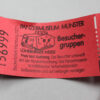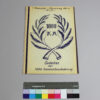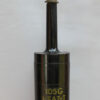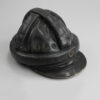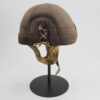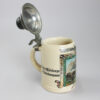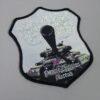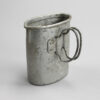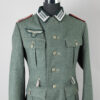Tickets to the Tank Museum, 2003
Inventory number: DPM 6.2062
The German Tank Museum Munster opened its doors for the first time in September 1983. Prior to this, the vehicles had already been on display at the Bundeswehr’s educational collection, but were not open to the general public. Complicated special regulations were necessary if civilians wanted to see the tanks and despite this hurdle, several thousand people a year found their way to the teaching collection even at this stage. As expected, interest in the public exhibition was already very high in the first year after opening, and from 1984 to 1987 the annual number of visitors rose from around 38,569 to 72,441 and fluctuated between 70,000 and 80,000 from then on. In the late 1990s and 2000s, public interest declined somewhat and the number of visitors tended to fluctuate between 60,000 and 70,000. Since 2008, however, this figure has risen again thanks to new public relations work and in 2013 the Tank Museum recorded over 100,000 visits/year for the first time (104,297).
A lot has happened since the museum opened: New museum halls have been built, new exhibitions designed and new staff hired. The constant professionalization of the Panzermuseum can also be seen in the print products: The almost 70,000 visitors in 2003 were the last to receive such torn-off “roll tickets”. The approximately 1,000 red tickets on this roll were intended for groups, and there were also different colors for families (green), adults (blue) and schoolchildren and soldiers (white). At the beginning of 2004, a cash register system was introduced, ending the era of tear-off rolls as admission tickets and replacing them with printed tickets. Everyday objects, such as an admission ticket, which was probably often thrown away after a visit, now have the character of objects and are evidence of the museum’s history in its forty years of existence.
High visitor numbers are pleasing for a museum: of course, admission fees make a large contribution to financing the museum’s work. However, a high or increasing number of visitors also shows that the museum and its topics are socially relevant and can reach people with its content.
In addition to the number of visitors, it is also important for museums to know who is visiting the museum in the first place. In this way, museum offers can be better tailored to the needs, interests and prior knowledge of visitors. Museums carry out surveys for this purpose; the last survey carried out to date at the Panzermuseum dates back to 2014. With around 8,000 respondents, it was found that 78% of visitors were visiting the museum for the first time, while only 22% had been there several times. What is pleasing about this figure is that new people are attracted to the museum every year, for example those who heard about the museum for the first time from the media. However, it also shows that the motivation for a further visit can be increased with a wider range of attractions. People who can see everything in one day and the exhibition remains the same for years are less likely to return. The age structure is also interesting, as the Panzermuseum has a very young audience with a focus between the ages of 10 and 49. Another perhaps surprising result was that the majority of visitors have not served in the military at all, and if they have, then mainly as conscripts. These results give the museum makers tips on how, for example, the exhibition should be designed in terms of content, what the museum store should offer or how a lounge area should be designed. This can ensure that the museum and the exhibition are geared towards the majority of visitors and designed to be as accessible as possible for everyone.
Object of the month
(short) stories from the depot
Unfortunately, many objects cannot currently be shown in the exhibition for conservation reasons. Here you will find unusual objects and exciting stories of special pieces from the depot



